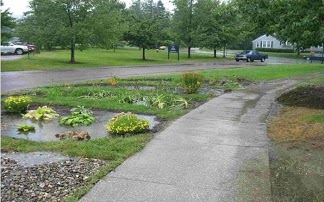For more than a decade, CLF has worked to secure the Clean Water Act’s promise of water quality that supports healthy fish populations and is safe for recreation in all the degraded urban streams flowing to Lake Champlain. A new CLF settlement with Vermont environmental regulators helps continue the momentum toward fulfillment of that promise.
Several years ago, CLF won a series of court cases that resulted in Vermont adopting pollution reduction targets for urban streams afflicted with an excess of fouled runoff. Some of that polluted runoff comes from the network of storm sewers and pipes owned by cities and towns. The runoff in these “municipal separate storm sewer systems” can contain a range of harmful pollutants including:
- sediment
- road salt
- oil slicks (those toxic rainbow slicks left behind by leaking cars)
- toxic metals
- bacteria (from animal waste)
- heat (think of how hot pavement gets in the summer–that heat transfers into rainwater coursing over blacktop)
- phosphorous (the key culprit in causing algae blooms in Lake Champlain)
In addition, these storm sewers are often too efficient at clearing rainwater and snowmelt from paved surfaces. The result can be flash flooding in streams swollen by unusually heavy flows caused by our artificial manipulation of the natural landscape’s drainage.

Green Infrastructure helps soak up precipitation and filter out pollutants running off paved surfaces. As an added bonus, these pollution control measures make urban environments look nicer and can help mitigate flash flooding. Photo Credit: Vermont Agency of Natural Resources
Scientists who developed the pollution reduction targets for Vermont’s urban streams have determined that there is a strong link between the overall amount of runoff being discharged and the amount of pollution reaching streams. The solution is to slow the flow and allow more precipitation to soak into the ground rather than run off paved surfaces. When placed in enough locations throughout our built landscape, “Green Infrastructure” such as rain gardens, permeable pavement, and constructed wetlands can restore the land’s natural ability to soak up precipitation and filter out pollutants before they reach streams.
Earlier this year, CLF challenged the permit regulating discharges of polluted runoff from numerous municipal storm sewers throughout Vermont. The permit is one of the main mechanisms for translating runoff reduction targets into on-the-ground pollution control measures like green infrastructure. Under the challenged permit, each polluting municipality designs its own cleanup plan, determining which pollution control measures to deploy and where to deploy them so as to achieve maximum runoff reduction. Unfortunately, the final version of the permit gave polluting municipalities up to twenty years to clean up their acts and also prevented meaningful public review of the cleanup plans each polluting city and town was devising for itself.
In response to these flaws, CLF challenged the permit. Fortunately, after extended settlement negotiations, Vermont environmental officials agreed that the permit needed fixing to ensure timely, transparent, and accountable cleanup efforts by each regulated city and town. The parties devised a settlement that addresses the flaws in the original permit related to the timing and transparency of the cleanup plans. First, Vermont officials have agreed that each municipality’s proposed cleanup plan will be subject to public notice and comment before agency approval, creating an opportunity for citizens to appeal any inadequate cleanup plans to the Environmental Court. Second, Vermont officials agreed to rescind the blanket twenty-year timeframe for cleanup plan completion contained in the original permit. Instead, Vermont regulators will make an individualized decision about the appropriateness of a schedule of compliance for each plan; those decisions will also be subject to public notice, comment, and appeal when necessary. The settlement maintains momentum in the restoration process for these streams and restores bedrock procedural public participation safeguards that are hallmarks of the Clean Water Act.